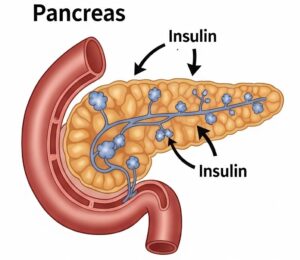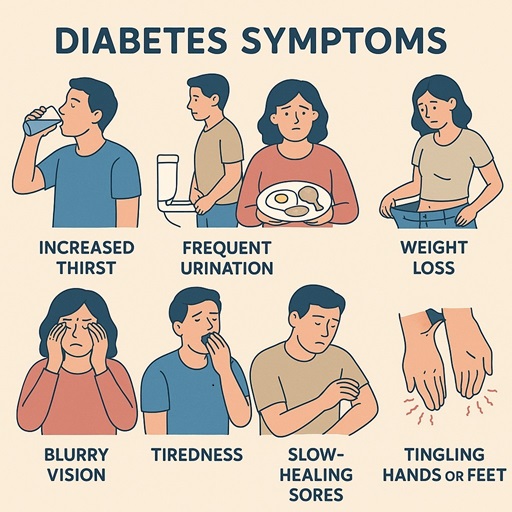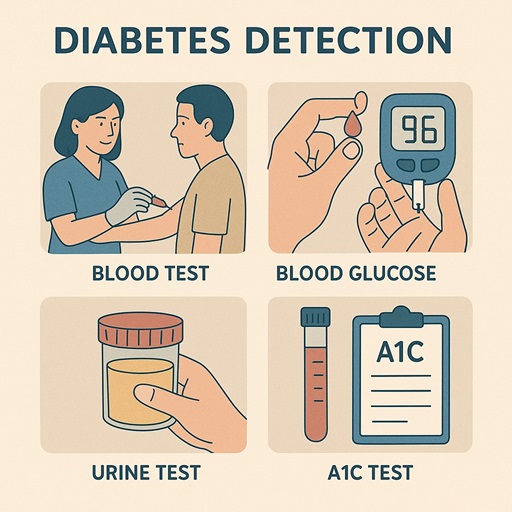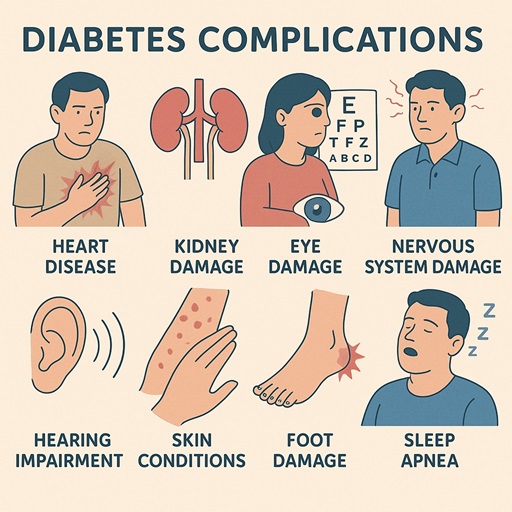
Diabetes Information
What is Diabetes
What is Diabetes?
Diabetes is a long-term condition where the body can’t use sugar (glucose) the right way. The body makes a hormone called insulin in the pancreas. Insulin’s job is to move sugar (glucose) from your blood into your cells so your body can use it for energy or store it for later. When your body doesn’t make enough insulin or can’t use it properly, sugar stays in the blood instead of going into the cells. This causes high blood sugar, which can cause health problems over time.
Why It Matters:
If diabetes isn’t managed, it can cause serious problems like heart disease, kidney damage, nerve pain, and vision loss. With the right care, people with diabetes can live long, healthy lives.
TYPES OF DIABETES
Type 1 Diabetes
Type 1 diabetes is a condition where the body’s immune system attacks the beta cells in the pancreas that make insulin. Insulin is a hormone that helps control blood sugar. When these cells are destroyed, the body can’t make insulin, so blood sugar cannot be regulated. The exact cause has not be determined, but it may involve genes and certain infections.
Symptoms: Type 1 diabetes is usually diagnosed in children, teenagers, or young adults. Common symptoms include frequent urination, extreme thirst, unexplained weight loss, fatigue, irritability, blurred vision, and in some cases, fruity smelling breath, which can signal diabetic ketoacidosis (a serious complication).
Treatment: Type 1 diabetes need daily insulin therapy through injections or an insulin pump. Managing this condition also involves regular blood sugar monitoring, healthy diet and exercise.
Type 2 Diabetes
Type 2 diabetes happens when the body doesn’t use insulin well or doesn’t make enough insulin to keep blood sugar normal. At first, the pancreas tries to make extra insulin, but over time it can’t keep up (insulin resistance), and blood sugar stays too high. This is the most common type of diabetes. It is strongly linked to lifestyle habits like unhealthy eating, not being active, and being overweight, but family history and genes also play a role. Prediabetes is an intermediate condition where blood sugar levels are higher than normal but not yet high enough to be classified as full blown diabetes. This stage is important because you can still reverse it by making healthy changes early.
Symptoms: Symptoms of Type 2 diabetes often develop slowly and can include increased thirst and hunger, frequent urination, fatigue, blurred vision, slow healing wounds, and numbness or tingling in the hands or feet. Many people may not realize they have it until complications arise.
Treatment: Treatment typically starts with lifestyle changes like adopting a healthier diet, exercising regularly, and losing weight. Oral medications such as metformin are commonly used, and insulin therapy may become necessary as the disease progresses. With proper management, people with Type 2 diabetes can prevent or delay complications, but if left uncontrolled, it can lead to serious issues such as heart disease, kidney failure, nerve damage, and vision loss.
Gestational Diabetes
This form of diabetes is diagnosed during the second or third trimester of pregnancy in women not previously known to have diabetes. It arises from an inadequate pancreatic beta cell response to the significant insulin resistance induced by pregnancy hormones. These hormones render the body’s insulin less effective, typically starting around 20 to 24 weeks of gestation. The symptoms usually resolve after delivery.
Can Diabetes be reversed?
Diabetes reversal primarily applies to Type 2 Diabetes and Prediabetes, where significant evidence supports the possibility of achieving glucose control without medication. For Type 1 Diabetes, research focuses on functional restoration through advanced therapies. Click on the link below for a detailed analysis of diabetes reversal:
01.
Symptoms
Here are the most common symptoms of diabetes.
- Frequent urination – The kidneys work overtime to filter and remove excess sugar through urine.
- Excessive thirst – Caused by dehydration from frequent urination.
- Unexplained weight loss – The body starts breaking down muscle and fat for energy when it can’t use glucose.
- Increased hunger – Glucose isn’t reaching cells, so your body signals for more food.
- Fatigue – Lack of insulin or insulin resistance prevents sugar from entering cells for energy.
- Blurred vision – High blood sugar causes swelling in the lens of the eye.
- Slow healing wounds or frequent infections – High blood sugar impairs the immune system and blood flow.
- Numbness or tingling in hands and feet – A sign of nerve damage from prolonged high blood sugar.
- Other Signs – Dry skin or frequent skin infections; Irritability or mood swings; Dark patches of skin, especially around the neck or armpits.

02.
Detect
Detecting diabetes involves medical tests that measure blood sugar (glucose) levels.
1. Fasting Blood Sugar Test: Measures blood glucose after not eating for at least 8 hours.
- Normal: Less than 100 mg/dL
- Prediabetes: 100–125 mg/dL
- Diabetes: 126 mg/dL or higher
2. Oral Glucose Tolerance Test (OGTT): Measures how your body handles sugar 2 hours after drinking a sugary drink.
- Normal: Below 140 mg/dL
- Prediabetes: 140–199 mg/dL
- Diabetes: 200 mg/dL or higher
3. HbA1c (A1C) Test: Measures your average blood sugar over the past 3 months. This is best way to measure your diabetes level.
- Normal: Below 5.7%
- Prediabetes: 5.7%–6.4%
- Diabetes: 6.5% or higher

03.
Risk Factors
There are many triggers for diabetes.
- Genetics (family history)
- Obesity, especially belly fat
- Lack of physical activity
- Poor diet (high sugar, high refined carbs)
- Aging – risk increases with age
- Chronic stress & poor sleep
- Inflammation & hormonal imbalances

04.
Complications
Uncontrolled diabetes can lead to serious short term and long term complications affecting nearly every organ system in the body. These complications arise primarily due to prolonged high blood sugar, which damages blood vessels and nerves.
1. Brain & Nervous System
- Stroke: Due to damage in brain blood vessels
- Neuropathy (nerve damage): Especially in legs and feet, causing Numbness, tingling, burning pain and loss of sensation
2. Eyes
- Diabetic retinopathy: Damage to retina, can lead to blindness
- Cataracts: Clouding of the eye lens
- Glaucoma: Increased eye pressure damaging the optic nerve
3. Heart & Blood Vessels
- Heart disease (coronary artery disease)
- High blood pressure
- Atherosclerosis (narrowed arteries)
- Increased risk of heart attack and stroke
4. Limbs (Especially Feet)
- Foot ulcers: Due to poor circulation and nerve damage
- Infections: Can become severe or chronic
- Amputation: In extreme cases due to gangrene or untreatable infections
5. Kidneys
- Diabetic nephropathy: Damage to kidney filters
- Can lead to chronic kidney disease or kidney failure (dialysis may be needed)
6. Metabolic & General
- Diabetic ketoacidosis: Life threatening
- Hyperosmolar hyperglycemic state: severe dehydration and very high blood sugar
- Frequent infections: Skin, gum, urinary tract
- Delayed healing: Especially for cuts or wounds
7. Cognitive & Mental Health
- Increased risk of dementia and Alzheimer’s
- Depression and anxiety


